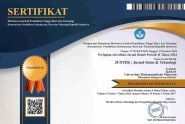Cytotoxic Activity of Volatile Compounds in Cymbopogon nardus’ Essential Oils
Abstract
Abstract: Plants produce a variety of secondary metabolites, one of which is essential oils that contain a variety of volatile compounds and are useful for humans. Cymbopogon nardus contains volatile compounds that can inhibit the proliferation of cancer cells. This research aims to explore the antiproliferation activity of C.nardus’ essential oils with different concentrations against breast cancer Michigan Cancer Foundation-7 (MCF-7) cells. Antiproliferation test was carried out with total cells method using trypan blue and cells were calculated using a microscope. Gas Chromatography-Mass Spectrometer (GC-MS) was performed to identify the volatile compounds. The results showed that the Inhibitory Concentration 50 (IC50) value was 359.6 ppm with an inhibition percent of 44.49% at 170 ppm. Meanwhile, inhibition percent against Vero normal cell was 29.04%, compared to Doxorubicin 35.23%. The dominant volatile compound in C. nardus’ essential oil were Geraniol and Citronellol.
Abstrak Tanaman menghasilkan berbagai macam metabolit sekunder, salah satunya dalam bentuk minyak atsiri yang mengandung berbagai macam senyawa volatil yang berguna bagi manusia. Cymbopogon nardus mengandung senyawa volatil yang dapat menghambat proliferasi sel kanker. Penelitian ini bertujuan untuk mengetahui aktifitas antiproliferasi minyak atsiri C. nardus dengan beberapa konsentrasi terhadap sel kanker payudara Michigan State Foundation-7 (MCF-7). Uji antiproliferasi dilakukan dengan metode total sel menggunakan trypan blue dan sel dihitung menggunakan mikroskop. Gas Chromatography-Mass Spectrometer (GC-MS) dilakukan untuk mengidentifikasi senyawa volatil. Hasil menunjukkan bahwa konsentrasi penghambatan 50 (IC50) sebesar 359.6 ppm dengan persen penghambatan sebesar 44.49% pada konsentrasi 170 ppm. Sementara itu, persen ihibisi terhadap sel normal Vero sebesar 29.04%, dibandingkan dengan Doksorubisin yang sebesar 35.23%. Senyawa volatil dominan yang terdapat pada C. nardus adalah Geraniol dan Citronellol.
Keywords
Full Text:
PDFReferences
Akhila, A. (2010). Essential Oil-Bearing Grasses: The Genus Cymbopogon. United States: CRC Press.
Amin, A., Gali-Muhtasib, H., & Schneider-Stock, R. (2009). Overview of Major Classes of Plant- Derived Anti-Cancer Drugs. International Journal of Biomedical Science, 5(1), 1–11. PMID: 23675107; PMCID: PMC3614754.
Araújo-Filho, H. G., Dos Santos, J. F., Carvalho, M., Picot, L., Fruitier-Arnaudin, I., Groult, H.,Quintans-Júnior, L. J., & Quintans, J. (2021). Anticancer Activity of Limonene: A Systematic Review of Target Signaling Pathways. Phytotherapy research. 35(9), 4957– 4970. https://doi.org/10.1002/ptr.7125.
Blowman, K., Magalhães, M., Lemos, M., Cabral, C., & Pires, I.M. (2018). Anticancer Properties of Essential Oils and Other Natural Products. Evidence-Based Complementary and Alternative Medicine, 3149362. https://doi.org/10.1155/2018/3149362.
Bruton, L., Lazo, J.S., & Parker, K.L. (2005). Goodman & Gilman’s The Pharmacological Basis of Therapeutics 11th Ed. New York: Mc Graw Hill Lange.
Cao, H., Li, Z., Li, R., Mao, B., Liu, C., Li, Y., & Zhang, G. (2018). Study On Anticancer Effect of Synthetic Biogenic Source of Germacrene A. Journal of Drug Delivery and Therapeutics, 8(5), 421-429. https://doi.org/10.22270/jddt.v8i5.1896.
Carnesecchi, S., Langley, K., Exinger, F., Gosse, F, & Raul, F. (2002). Geraniol, A Component of Plant Essential Oils, Sensitizes Human Colonic Cancer Cells To 5- Fluorouracil Treatment. Journal of Pharmacology and Experimental Therapeutics. 301(2), 625-630. https://doi.org/10.1124/jpet.301.2.625.
Cassel, E., & Vargas, R. (2013). Experiments and Modelling of The Cymbopogon nardus Essential Oil Extraction By Steam Distillation. Journal of the Mexican Chemical Society. 50(3), 126- 129.
Dahham, S.S., Tabana, Y.M., Iqbal, M.A., Ahamed, M.B., Ezzat, M.O., & Majid, A.S. (2015). The Anticancer, Antioxidant and Antimicrobial Properties of The Sesquiterpene Β-Caryophyllene From The Essential Oil of Aquilaria crassna. Molecules. 20(7), 11808–11829. https://doi.org/10.3390/molecules200711808.
Duncan, R.E., Lau, D., El-Sohemy, A., & Archer, M.C. (2004). Geraniol and Beta-Ionone Inhibit Proliferation, Cell Cycle Progression, and Cyclin-Dependent Kinase 2 36 Activity in MCF-7 Breast Cancer Cells Independent of Effects on HMG-CoA Reductase Activity. Biochemical Pharmacology. 68(9), 1739-1747. https://doi.org/10.1016/j.bcp.2004.06.022.
Ghosh, A., Banik, S., & Islam, M. (2015). In Vitro Thrombolytic, Anthelmintic, Anti-Oxidant and Cytotoxic Activity with Phytochemical Screening of Methanolic Extract of Xanthium indicum Leaves. Bangladesh Journal of Pharmacology. 10(4), 854-59. https://doi.org/10.3329/bjp.v10i4.23829.
Hasim., Nasution, S.P., Kurniawati, S.O., & Rachmawati, I. (2020). Aktivitas Sitotoksik Sitral Serai sebagai Antikanker Payudara MCM-B2. Current Biochemistry, 7(1), 29-36. https://doi.org/10.29244/cb.7.1.4.
Koba, K., Sanda, K., Guyon, C., Raynaud, C., & Chaumont, J.P. (2009). In Vitro Cytotoxic Activity of Cymbopogon citratus L and Cymbopogon nardus L Essential Oils from Togo. Bangladesh Journal of Pharmacology. 4(1),29-34. https://doi.org/10.3329/bjp.v4i1.1040.
Luo, L., Jia, J. J., Zhong, Q., Zhong, X., Zheng, S., Wang, G., & He, L. (2020). Synthesis and Anticancer Activity Evaluation of Naphthalene-Substituted Triazole Spirodienones. European Journal of Medicinal Chemistry, 213, 113039. https://doi.org/10.1016/j.ejmech.2020.113039.
Mc Donald, S., Saslow, D., & Alciati,M.H., (2014). Performance and Reporting of Clinical Breast Examination: A Review of The Literature. CA: A Cancer Journal for Clinicians, 54(6), 345-361. https://doi.org/10.3322/canjclin.54.6.345.
Meyer, B.N., Ferrigni, N.R., Putnam, J.E,. Jacobsen, L.B., Nichols, D.E., & Mclaughlin, J.L. (1982). Brine Shrimp: A Convenient General Bioassay For Active Plant Constituents. Planta Medica. 45 (5), 31-34. https://doi.org/10.1055/s-2007-971236 .
Prayong, P., Barusruxb, S., & Weerapreeyakul, N. (2008). Cytotoxic Activity Screening of Some Indigenous Thai Plants. Fitoterapia. 79 (7-8), 598–601. https://doi.org/10.1016/j.fitote.2008.06.007.
Priosoeryanto, B.P., Tateyama, S., Yamaguchi, R., &Uchida K. (1995). Antiproliferation and Colony Forming Inhibition Activities of Recombinant Feline Interferon (rFeIFN) on Various Cells In Vitro. Canadian journal of veterinary research. 59 (1), 272-276. PMID: 7704845 PMCID: PMC1263736.
Saini, A., Kumar, M., Bhatt, S., Saini, V., & Malik, A. (2020). Cancer Causes and Treatments. International Journal of Pharmaceutical Sciences and Research, 11(7), 3109-3122. https://doi.org/10.13040/IJPSR.0975-8232.
Sharma, G.N., Dave, R., Sanadya, J., Sharma, P., & Sharma, K.K. (2010). Various Types and Management of Breast Cancer: An Overview. Journal of Advanced Pharmaceutical Technology & Research, 1(2), 109 – 126. PMID: 22247839; PMCID: PMC3255438.
Sitarek, P., Rijo, P., Garcia, C., Skala, E., Kalemba, D., Bialas, A.J., Szemraj, J., Pytel, D., Toma, M., Wysokinska, H., & Sliwinski T. (2017). Antibacterial, Anti-Inflammatory, Antioxidant, and Antiproliferative Properties of Essential Oils from Hairy and Normal Roots of Leonurus sibiricus L. and Their Chemical Composition. Oxidative Medicine and Cellular Longevity. 1-12. https://doi.org/10.1155/2017/7384061.7384061.
Stone, S.C., Vasconcellos, F.A., Lenardao, E.J., do Amaral, R.C., Jacob, R.G., & Leivas, L.F.P. (2013). Evaluation of Potential Use of Cymbopogon Sp. Essential Oils, (R)- Citronellal and N- Citronellylamine in Cancer Chemotherapy. International Journal of Applied Research in Natural Products. 6(4), 11-15.
Sun, Y.S., Zhao, Z., Yang, Z.N., Xu, F., Lu, H.J., Zhu, Z.Y., Shi, W., Jiang, J., Yao, P.P., & Zhu, H.P. (2017). Risk Factors and Preventions of Breast Cancer. International Journal of Biological Sciences, 13(11), 1387-1397. https://doi.org/10.7150/ijbs.21635.
Sung, H., Ferlay, J., Siegel, R.L., Laversanne, M., Soerjomataram, I., Jemal, A., & Bray, F. (2021). Global Cancer Statistics 2020: GLOBOCAN Estimates of Incidence and Mortality Worldwide for 36 Cancers in 185 Countries. CA: A Cancer Journal for Clinicians, 71(3), 209-249. https://doi.org/10.3322/caac.21660.
Zeng, S., Kapur, A., Patankar, M.S., & Xiong, M.P. (2015). Formulation, Characterization, and Antitumor Properties of Trans- and Cis-Citral in the 4T1 Breast Cancer Xenograft Mouse Model. Journal of Pharmacy Research. 32(8), 2548–2558. https://doi.org/10.1007/s11095-015-1643-0
Zhuang, S.R., Chen, S.L., Tsai, J.H., Huang, C.C., Wu, T.C., Liu, W.S., Tseng, H.C., Lee, H.S., & Huang, M.C. (2009). Effect Of Citronellol And The Chinese Medical Herb Complex On Cellular Immunity Of Cancer Patients Receiving Chemotherapy/Radiotherapy. Phytotherapy Research. 23(6): 785-790. https://doi.org/10.1002/ptr.2623
DOI: https://doi.org/10.31764/justek.v5i2.10194
Refbacks
- There are currently no refbacks.
JUSTEK : Jurnal Sains dan Teknologi sudah terindeks
EDITORIAL OFFICE:












.JPG)

